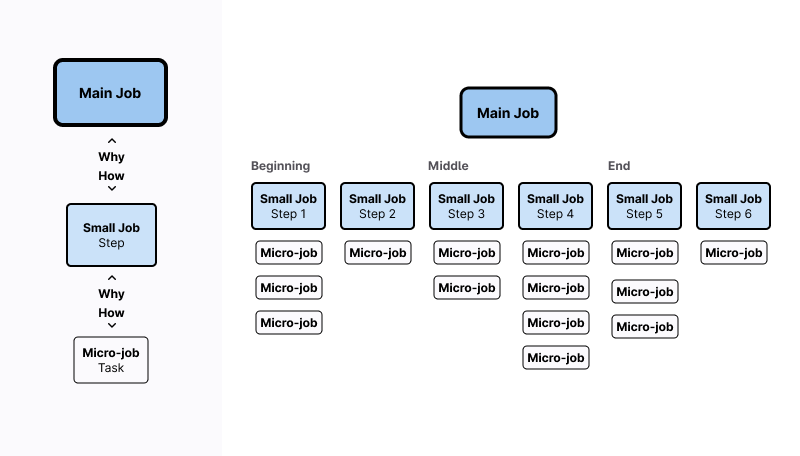Jobs to be Done at GitLab
The material in this page and related pages (Playbook, Beyond the Playbook) draws from Jim Kalbach and his book, “The Jobs to be Done Playbook”.
For practical JTBD research guidance, see the playbook. For a deep dive into each aspect of a job canvas, review the Anatomy of a JTBD canvas.
Note: The previous JTBD source (yml file, internal only) is being replaced. Teams should track JTBD work in FigJam until a new handbook page is created.
Main Jobs to micro jobs
When talking about Jobs to be Done, we’re often talking about different levels of jobs. It’s important to note the differences in terminology between these levels so that you and your stakeholders can communicate effectively.

Main Jobs
A Main Job is a means to an end. It’s an act that will be performed and should have a clear end state (the “done” part of JTBD). That is why we write jobs in the pattern Verb + Object + Clarifier when writing job statements.
Example: Buy a new home
Small jobs
Small Jobs are more practical and correspond to a process or workflow. They answer the question, “How does the job get done?” in the context of the Main Job and moves the user closer to accomplishing their goal.
Example: Put in an offer on a house
Micro-jobs
Micro-jobs are the small tasks a user may undergo to accomplish their small job and Main Job. Micro-jobs should be self-explanatory and easy to understand without much context.
Example: Decide how much you’re going to offer in relation to the asking price.
It’s important to be able to identify and correctly place jobs at the right altitude as you work through the Jobs to be Done process. It will help keep you focused on the Main Job and allow you to quickly incorporate (or discard) new information that you hear during interviews into your job steps.
JTBD - Beyond the Playbook
JTBD Research Playbook
Validated GitLab JTBD Canvases and Opportunity Scores
9b1952da)
